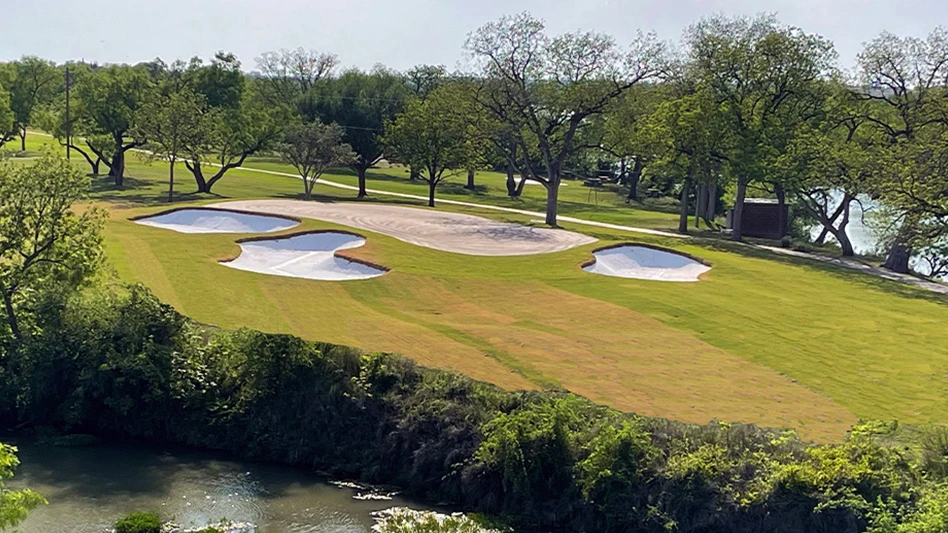
Most golf course superintendents prepare for the possibility of winterkill turf damage. Even in warmer climates, it is part of the job. But there are misconceptions about winterkill, and those lead superintendents to make incorrect conclusions and wrong decisions in turf and disease management.
One popular notion concerns ice on putting surfaces and the idea that there is a point which it must always be removed, says United States Golf Association Director of Green Section Education Adam Moeller.
“Probably one of the more common misconceptions out there is, there is a set day — after 20 days, 30 days, whatever — that there has to be action taken,” Moeller says. “The research is somewhat misleading that if you’ve got ice cover for a certain time period, that means there is going to be injury. I think that’s how some people have interpreted that research.”
Many factors affect a course’s susceptibility to ice damage, Moeller says. In fact, some courses can experience turf injury when ice has been present for only a short time period. “In some cases, they can have ice for a long period of time and their greens can be fine,” he says.
A superintendent must weigh numerous factors when dealing with an ice issue, Moeller says. For example, how long the ice has been present?
“The thickness of the ice is going to increase your risk,” he says. “If you’ve got a really thick ice layer, especially one that is very clear. If you have ice that looks a little bit cloudy, most times it seems like there’s a little bit more oxygen in that ice and it’s maybe not as prone to causing (turf damage). But if you’ve got a really thick ice layer — two-, three-, four-inches thick — that’s obviously a recipe for problems and certainly a cause for concern.”
Other factors in the ice equation include how rapidly the ice formed and the strength of the turf heading into the winter.
“Every ice event is sort of unique, if you will,” Moeller says. “There are a lot of factors involved beyond just ‘Hey, I’ve had ice for X amount of days.’”
Removing ice from greens can do more harm than good, says Dr. Michelle DeCosta, associate professor of turfgrass physiology at the University of Massachusetts.

“It’s not just about the presence of ice, it’s about what the conditions of the turf was before the ice was present,” she says. “People will pull the trigger and go out and try to remove the ice. And sometimes in exposing the grass underneath to whatever ambient or fluctuating temperature conditions, that can actually cause damage. So sometimes people are better off just kind of letting it go or keeping it there and using other information to help them determine what to do.”
Snow is a different matter. A prolonged snow cover is a natural insulator for the turf beneath it, protecting the soil and the plant from potentially harsh winter temperatures and winds. DeCosta, though, notes a pattern featuring snow, followed by melting or perhaps rain because of fluctuating temperatures, can be problematic for turf.
“If you’ve got snow and then you’ve got rainfall or some other sort of precipitation and then you’ve got rain turning to ice and then you’ve got melting, that’s when you start to run into some issues,” she says.
This game of climate ping pong causes physiological shifts in the plants and their crowns about whether to come out or stay in dormancy. “There are these environmental signals going back in forth but then, on top of it, worse than the temperature fluctuations actually, are the fluctuations in moisture content due to the presence of free water,” DeCosta says. “That’s’ a really bad situation that superintendents need to deal with as snow starts to melt.”
Winterkill is particularly painful when it happens to your greens. The first thing is communicating to the facility’s key decision maker — whether that’s an owner, a general manager, a green committee member — that unfortunate winter injury has occurred
Next, put a plan together to repair the damage, and then, along the lines of planning for that repair, consider taking steps to prevent future recurrences.
“It’s specifically about trying to get the greens back and recovered,” Moeller says. “The biggest thing I think superintendents have success with is warming the greens, warming the soil as quickly as possible. That will promote the quickest recovery, through seeding, through sodding or whatever method they might choose.
Most turf varieties have been developed to withstand some occurrences of huge temperature fluctuations, especially if you’ve followed standard maintenance practices for your part of the country.
In the end, dealing with and minimizing winterkill is a year-round endeavor.
“(Winterkill) is an indication that you really had a lot of things going on that are really not associated with winter kill,” BASF’s Dr. Kathie Kalmowitz says. “You really had potentially much weaker turf; even if the top of the turf was fairly green going into the fall, you really didn’t have a good robust root system to support the turf and the winterkill has brought that glaringly to light.
“If (your winterkill issues) really are somewhat more severe than your neighbor down the road, it really means that you were kind of camouflaging some chronic problems that may have been going on on your course,” she adds.

Explore the March 2018 Issue
Check out more from this issue and find your next story to read.
Latest from Golf Course Industry
- PBI-Gordon promotes Jeff Marvin
- USGA investing $1 million into Western Pennsylvania public golf
- KemperSports taps new strategy EVP
- Audubon International marks Earth Day in growth mode
- Editor’s notebook: Do your part
- Greens with Envy 66: A Southern spring road trip
- GCSAA’s Rounds 4 Research auction begins
- Quali-Pro hires new technical services manager





